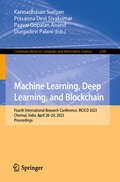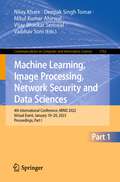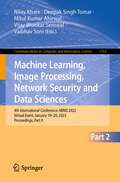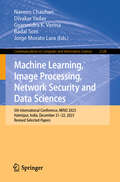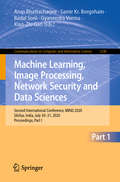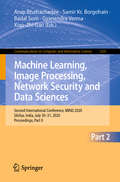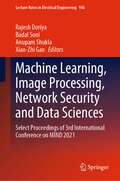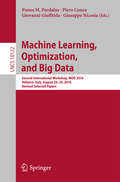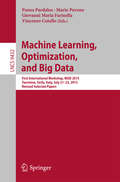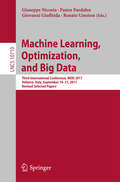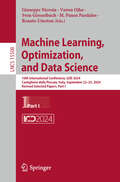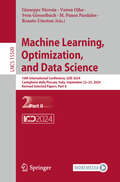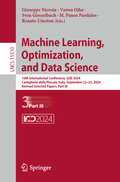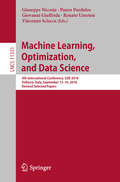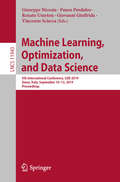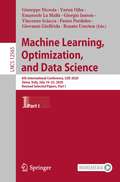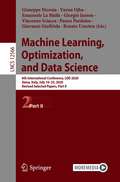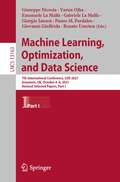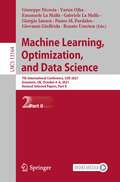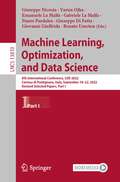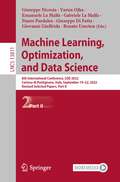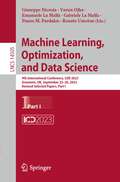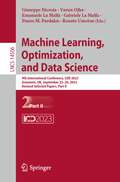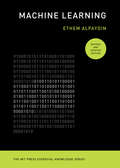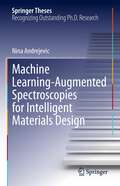- Table View
- List View
Machine Learning, Deep Learning, and Blockchain: Fourth International Research Conference, IRCICD 2023, Chennai, India, April 28–29, 2023, Proceedings (Communications in Computer and Information Science #2385)
by Prasanna Devi Sivakumar Kannadhasan Suriyan Paavai Gopalan Anand Durgadevi PalaniThis book constitutes the refereed proceedings of Fourth International Research Conference on Machine Learning, Deep Learning, and Blockchain, IRCICD 2023, held in Chennai, India, during April 28–29, 2023. The 9 full papers presented were carefully reviewed and selected from 147 submissions. They were organized in topical sections as follows: machine learning; deep learning; and block chain.
Machine Learning, Image Processing, Network Security and Data Sciences: 4th International Conference, MIND 2022, Virtual Event, January 19–20, 2023, Proceedings, Part I (Communications in Computer and Information Science #1762)
by Vijay Bhaskar Semwal Mitul Kumar Ahirwal Nilay Khare Deepak Singh Tomar Vaibhav SoniThis two-volume set (CCIS 1762-1763) constitutes the refereed proceedings of the 4th International Conference on Machine Learning, Image Processing, Network Security and Data Sciences, MIND 2022, held in Bhopal, India, in December 2022. The 64 papers presented in this two-volume set were thoroughly reviewed and selected from 399 submissions. The papers are organized according to the following topical sections: machine learning and computational intelligence; data sciences; image processing and computer vision; network and cyber security.
Machine Learning, Image Processing, Network Security and Data Sciences: 4th International Conference, MIND 2022, Virtual Event, January 19–20, 2023, Proceedings, Part II (Communications in Computer and Information Science #1763)
by Vijay Bhaskar Semwal Mitul Kumar Ahirwal Nilay Khare Deepak Singh Tomar Vaibhav SoniThis two-volume set (CCIS 1762-1763) constitutes the refereed proceedings of the 4th International Conference on Machine Learning, Image Processing, Network Security and Data Sciences, MIND 2022, held in Bhopal, India, in December 2022. The 64 papers presented in this two-volume set were thoroughly reviewed and selected from 399 submissions. The papers are organized according to the following topical sections: machine learning and computational intelligence; data sciences; image processing and computer vision; network and cyber security.
Machine Learning, Image Processing, Network Security and Data Sciences: 5th International Conference, MIND 2023, Hamirpur, India, December 21–22, 2023, Revised Selected Papers (Communications in Computer and Information Science #2128)
by Badal Soni Gyanendra K. Verma Naveen Chauhan Divakar Yadav Jorge Morato LaraThis book constitutes the refereed proceedings of the 5th International Conference on Machine Learning, Image Processing, Network Security and Data Sciences, MIND 2023, held in Hamirpur, India, during December 21–22, 2023. The 29 full papers included in this book were carefully reviewed and selected from 173 submissions. They were organized in topical sections as follows: Machine Learning; Image Processing; Network Security; and Data Sciences.
Machine Learning, Image Processing, Network Security and Data Sciences: Second International Conference, MIND 2020, Silchar, India, July 30 - 31, 2020, Proceedings, Part I (Communications in Computer and Information Science #1240)
by Xiao-Zhi Gao Arup Bhattacharjee Samir Kr. Borgohain Badal Soni Gyanendra VermaThis two-volume set (CCIS 1240-1241) constitutes the refereed proceedings of the Second International Conference on Machine Learning, Image Processing, Network Security and Data Sciences, MIND 2020, held in Silchar, India. Due to the COVID-19 pandemic the conference has been postponed to July 2020. The 79 full papers and 4 short papers were thoroughly reviewed and selected from 219 submissions. The papers are organized according to the following topical sections: data science and big data; image processing and computer vision; machine learning and computational intelligence; network and cyber security.
Machine Learning, Image Processing, Network Security and Data Sciences: Second International Conference, MIND 2020, Silchar, India, July 30 - 31, 2020, Proceedings, Part II (Communications in Computer and Information Science #1241)
by Xiao-Zhi Gao Arup Bhattacharjee Samir Kr. Borgohain Badal Soni Gyanendra VermaThis two-volume set (CCIS 1240-1241) constitutes the refereed proceedings of the Second International Conference on Machine Learning, Image Processing, Network Security and Data Sciences, MIND 2020, held in Silchar, India. Due to the COVID-19 pandemic the conference has been postponed to July 2020. The 79 full papers and 4 short papers were thoroughly reviewed and selected from 219 submissions. The papers are organized according to the following topical sections: data science and big data; image processing and computer vision; machine learning and computational intelligence; network and cyber security.
Machine Learning, Image Processing, Network Security and Data Sciences: Select Proceedings of 3rd International Conference on MIND 2021 (Lecture Notes in Electrical Engineering #946)
by Xiao-Zhi Gao Anupam Shukla Badal Soni Rajesh DoriyaThis book constitutes the refereed proceedings of the Third International Conference on Machine Learning, Image Processing, Network Security and Data Sciences, MIND 2021. The papers are organized according to the following topical sections: data science and big data; image processing and computer vision; machine learning and computational intelligence; network and cybersecurity. This book aims to develop an understanding of image processing, networks, and data modeling by using various machine learning algorithms for a wide range of real-world applications. In addition to providing basic principles of data processing, this book teaches standard models and algorithms for data and image analysis.
Machine Learning, Optimization, and Big Data
by Panos M. Pardalos Giuseppe Nicosia Piero Conca Giovanni GiuffridaThis book constitutes revised selected papers from the Second International Workshop on Machine Learning, Optimization, and Big Data, MOD 2016, held in Volterra, Italy, in August 2016. The 40 papers presented in this volume were carefully reviewed and selected from 97 submissions. These proceedings contain papers in the fields of Machine Learning, Computational Optimization and DataScience presenting a substantial array of ideas, technologies, algorithms, methods and applications.
Machine Learning, Optimization, and Big Data
by Panos Pardalos Vincenzo Cutello Mario Pavone Giovanni Maria FarinellaThis bookconstitutes revised selected papers from the First International Workshop onMachine Learning, Optimization, and Big Data, MOD 2015, held in Taormina, Sicily,Italy, in July 2015. The 32papers presented in this volume were carefully reviewed and selected from 73submissions. They deal with the algorithms, methods and theories relevant indata science, optimization and machine learning.
Machine Learning, Optimization, and Big Data: Third International Conference, MOD 2017, Volterra, Italy, September 14–17, 2017, Revised Selected Papers (Lecture Notes in Computer Science #10710)
by Panos Pardalos Giuseppe Nicosia Giovanni Giuffrida Renato UmetonThis book constitutes the post-conference proceedings of the Third International Workshop on Machine Learning, Optimization, and Big Data, MOD 2017, held in Volterra, Italy, in September 2017.The 50 full papers presented were carefully reviewed and selected from 126 submissions. The papers cover topics in the field of machine learning, artificial intelligence, computational optimization and data science presenting a substantial array of ideas, technologies, algorithms, methods and applications.
Machine Learning, Optimization, and Data Science: 10th International Conference, LOD 2024, Castiglione della Pescaia, Italy, September 22–25, 2024, Revised Selected Papers, Part I (Lecture Notes in Computer Science #15508)
by Giuseppe Nicosia Renato Umeton Varun Ojha Sven Giesselbach M. Panos PardalosThe three-volume set LNAI 15508-15510 constitutes the refereed proceedings of the 10th International Conference on Machine Learning, Optimization, and Data Science, LOD 2024, held in Castiglione della Pescaia, Italy, during September 22–25, 2024. This year, in the LOD Proceedings decided to also include the papers of the fourth edition of the Symposium on Artificial Intelligence and Neuroscience (ACAIN 2024). The 79 full papers included in this book were carefully reviewed and selected from 127 submissions. The LOD 2024 proceedings focus on machine learning, deep learning, AI, computational optimization, neuroscience and big data that includes invited talks, tutorial talks, special sessions, industrial tracks, demonstrations and oral and poster presentations of refereed papers.
Machine Learning, Optimization, and Data Science: 10th International Conference, LOD 2024, Castiglione della Pescaia, Italy, September 22–25, 2024, Revised Selected Papers, Part II (Lecture Notes in Computer Science #15509)
by Giuseppe Nicosia Renato Umeton Varun Ojha Sven Giesselbach M. Panos PardalosThe three-volume set LNAI 15508-15510 constitutes the refereed proceedings of the 10th International Conference on Machine Learning, Optimization, and Data Science, LOD 2024, held in Castiglione della Pescaia, Italy, during September 22–25, 2024. This year, in the LOD Proceedings decided to also include the papers of the fourth edition of the Symposium on Artificial Intelligence and Neuroscience (ACAIN 2024). The 79 full papers included in this book were carefully reviewed and selected from 127 submissions. The LOD 2024 proceedings focus on machine learning, deep learning, AI, computational optimization, neuroscience and big data that includes invited talks, tutorial talks, special sessions, industrial tracks, demonstrations and oral and poster presentations of refereed papers.
Machine Learning, Optimization, and Data Science: 10th International Conference, LOD 2024, Castiglione della Pescaia, Italy, September 22–25, 2024, Revised Selected Papers, Part III (Lecture Notes in Computer Science #15510)
by Giuseppe Nicosia Renato Umeton Varun Ojha Sven Giesselbach M. Panos PardalosThe three-volume set LNAI 15508-15510 constitutes the refereed proceedings of the 10th International Conference on Machine Learning, Optimization, and Data Science, LOD 2024, held in Castiglione della Pescaia, Italy, during September 22–25, 2024. This year, in the LOD Proceedings decided to also include the papers of the fourth edition of the Symposium on Artificial Intelligence and Neuroscience (ACAIN 2024). The 79 full papers included in this book were carefully reviewed and selected from 127 submissions. The LOD 2024 proceedings focus on machine learning, deep learning, AI, computational optimization, neuroscience and big data that includes invited talks, tutorial talks, special sessions, industrial tracks, demonstrations and oral and poster presentations of refereed papers.
Machine Learning, Optimization, and Data Science: 4th International Conference, LOD 2018, Volterra, Italy, September 13-16, 2018, Revised Selected Papers (Lecture Notes in Computer Science #11331)
by Panos Pardalos Giuseppe Nicosia Giovanni Giuffrida Renato Umeton Vincenzo SciaccaThis book constitutes the post-conference proceedings of the 4th International Conference on Machine Learning, Optimization, and Data Science, LOD 2018, held in Volterra, Italy, in September 2018.The 46 full papers presented were carefully reviewed and selected from 126 submissions. The papers cover topics in the field of machine learning, artificial intelligence, reinforcement learning, computational optimization and data science presenting a substantial array of ideas, technologies, algorithms, methods and applications.
Machine Learning, Optimization, and Data Science: 5th International Conference, LOD 2019, Siena, Italy, September 10–13, 2019, Proceedings (Lecture Notes in Computer Science #11943)
by Panos Pardalos Giuseppe Nicosia Giovanni Giuffrida Renato Umeton Vincenzo SciaccaThis book constitutes the post-conference proceedings of the 5th International Conference on Machine Learning, Optimization, and Data Science, LOD 2019, held in Siena, Italy, in September 2019. The 54 full papers presented were carefully reviewed and selected from 158 submissions. The papers cover topics in the field of machine learning, artificial intelligence, reinforcement learning, computational optimization and data science presenting a substantial array of ideas, technologies, algorithms, methods and applications.
Machine Learning, Optimization, and Data Science: 6th International Conference, LOD 2020, Siena, Italy, July 19–23, 2020, Revised Selected Papers, Part I (Lecture Notes in Computer Science #12565)
by Panos Pardalos Giuseppe Nicosia Giovanni Giuffrida Renato Umeton Vincenzo Sciacca Varun Ojha Emanuele La Malfa Giorgio JansenThis two-volume set, LNCS 12565 and 12566, constitutes the refereed proceedings of the 6th International Conference on Machine Learning, Optimization, and Data Science, LOD 2020, held in Siena, Italy, in July 2020.The total of 116 full papers presented in this two-volume post-conference proceedings set was carefully reviewed and selected from 209 submissions. These research articles were written by leading scientists in the fields of machine learning, artificial intelligence, reinforcement learning, computational optimization, and data science presenting a substantial array of ideas, technologies, algorithms, methods, and applications.
Machine Learning, Optimization, and Data Science: 6th International Conference, LOD 2020, Siena, Italy, July 19–23, 2020, Revised Selected Papers, Part II (Lecture Notes in Computer Science #12566)
by Panos Pardalos Giuseppe Nicosia Giovanni Giuffrida Renato Umeton Vincenzo Sciacca Varun Ojha Emanuele La Malfa Giorgio JansenThis two-volume set, LNCS 12565 and 12566, constitutes the refereed proceedings of the 6th International Conference on Machine Learning, Optimization, and Data Science, LOD 2020, held in Siena, Italy, in July 2020. The total of 116 full papers presented in this two-volume post-conference proceedings set was carefully reviewed and selected from 209 submissions. These research articles were written by leading scientists in the fields of machine learning, artificial intelligence, reinforcement learning, computational optimization, and data science presenting a substantial array of ideas, technologies, algorithms, methods, and applications.
Machine Learning, Optimization, and Data Science: 7th International Conference, LOD 2021, Grasmere, UK, October 4–8, 2021, Revised Selected Papers, Part I (Lecture Notes in Computer Science #13163)
by Panos M. Pardalos Giuseppe Nicosia Giovanni Giuffrida Renato Umeton Varun Ojha Emanuele La Malfa Giorgio Jansen Gabriele La MalfaThis two-volume set, LNCS 13163-13164, constitutes the refereed proceedings of the 7th International Conference on Machine Learning, Optimization, and Data Science, LOD 2021, together with the first edition of the Symposium on Artificial Intelligence and Neuroscience, ACAIN 2021.The total of 86 full papers presented in this two-volume post-conference proceedings set was carefully reviewed and selected from 215 submissions. These research articles were written by leading scientists in the fields of machine learning, artificial intelligence, reinforcement learning, computational optimization, neuroscience, and data science presenting a substantial array of ideas, technologies, algorithms, methods, and applications.
Machine Learning, Optimization, and Data Science: 7th International Conference, LOD 2021, Grasmere, UK, October 4–8, 2021, Revised Selected Papers, Part II (Lecture Notes in Computer Science #13164)
by Panos M. Pardalos Giuseppe Nicosia Giovanni Giuffrida Renato Umeton Varun Ojha Emanuele La Malfa Giorgio Jansen Gabriele La MalfaThis two-volume set, LNCS 13163-13164, constitutes the refereed proceedings of the 7th International Conference on Machine Learning, Optimization, and Data Science, LOD 2021, together with the first edition of the Symposium on Artificial Intelligence and Neuroscience, ACAIN 2021. The total of 86 full papers presented in this two-volume post-conference proceedings set was carefully reviewed and selected from 215 submissions. These research articles were written by leading scientists in the fields of machine learning, artificial intelligence, reinforcement learning, computational optimization, neuroscience, and data science presenting a substantial array of ideas, technologies, algorithms, methods, and applications.
Machine Learning, Optimization, and Data Science: 8th International Workshop, LOD 2022, Certosa di Pontignano, Italy, September 19–22, 2022, Revised Selected Papers, Part I (Lecture Notes in Computer Science #13810)
by Panos Pardalos Giuseppe Di Fatta Giuseppe Nicosia Giovanni Giuffrida Renato Umeton Varun Ojha Emanuele La Malfa Gabriele La MalfaThis two-volume set, LNCS 13810 and 13811, constitutes the refereed proceedings of the 8th International Conference on Machine Learning, Optimization, and Data Science, LOD 2022, together with the papers of the Second Symposium on Artificial Intelligence and Neuroscience, ACAIN 2022. The total of 84 full papers presented in this two-volume post-conference proceedings set was carefully reviewed and selected from 226 submissions. These research articles were written by leading scientists in the fields of machine learning, artificial intelligence, reinforcement learning, computational optimization, neuroscience, and data science presenting a substantial array of ideas, technologies, algorithms, methods, and applications.
Machine Learning, Optimization, and Data Science: 8th International Workshop, LOD 2022, Certosa di Pontignano, Italy, September 19–22, 2022, Revised Selected Papers, Part II (Lecture Notes in Computer Science #13811)
by Panos Pardalos Giuseppe Di Fatta Giuseppe Nicosia Giovanni Giuffrida Renato Umeton Varun Ojha Emanuele La Malfa Gabriele La MalfaThis two-volume set, LNCS 13810 and 13811, constitutes the refereed proceedings of the 8th International Conference on Machine Learning, Optimization, and Data Science, LOD 2022, together with the papers of the Second Symposium on Artificial Intelligence and Neuroscience, ACAIN 2022. The total of 84 full papers presented in this two-volume post-conference proceedings set was carefully reviewed and selected from 226 submissions. These research articles were written by leading scientists in the fields of machine learning, artificial intelligence, reinforcement learning, computational optimization, neuroscience, and data science presenting a substantial array of ideas, technologies, algorithms, methods, and applications.
Machine Learning, Optimization, and Data Science: 9th International Conference, LOD 2023, Grasmere, UK, September 22–26, 2023, Revised Selected Papers, Part I (Lecture Notes in Computer Science #14505)
by Panos M. Pardalos Giuseppe Nicosia Renato Umeton Varun Ojha Emanuele La Malfa Gabriele La MalfaThis book constitutes the refereed proceedings of the 9th International Conference on Machine Learning, Optimization, and Data Science, LOD 2023, which took place in Grasmere, UK, in September 2023. The 72 full papers included in this book were carefully reviewed and selected from 119 submissions. The proceedings also contain 9 papers from and the Third Symposium on Artificial Intelligence and Neuroscience, ACAIN 2023. The contributions focus on the state of the art and the latest advances in the integration of machine learning, deep learning, nonlinear optimization and data science to provide and support the scientific and technological foundations for interpretable, explainable and trustworthy AI.
Machine Learning, Optimization, and Data Science: 9th International Conference, LOD 2023, Grasmere, UK, September 22–26, 2023, Revised Selected Papers, Part II (Lecture Notes in Computer Science #14506)
by Panos M. Pardalos Giuseppe Nicosia Renato Umeton Varun Ojha Emanuele La Malfa Gabriele La MalfaThis book constitutes the refereed proceedings of the 9th International Conference on Machine Learning, Optimization, and Data Science, LOD 2023, which took place in Grasmere, UK, in September 2023. The 72 full papers included in this book were carefully reviewed and selected from 119 submissions. The proceedings also contain 9 papers from and the Third Symposium on Artificial Intelligence and Neuroscience, ACAIN 2023. The contributions focus on the state of the art and the latest advances in the integration of machine learning, deep learning, nonlinear optimization and data science to provide and support the scientific and technological foundations for interpretable, explainable and trustworthy AI.
Machine Learning, revised and updated edition: The New Ai (The MIT Press Essential Knowledge series)
by Ethem AlpaydinA concise overview of machine learning--computer programs that learn from data--the basis of such applications as voice recognition and driverless cars.Today, machine learning underlies a range of applications we use every day, from product recommendations to voice recognition--as well as some we don't yet use everyday, including driverless cars. It is the basis for a new approach to artificial intelligence that aims to program computers to use example data or past experience to solve a given problem. In this volume in the MIT Press Essential Knowledge series, Ethem Alpaydin offers a concise and accessible overview of "the new AI." This expanded edition offers new material on such challenges facing machine learning as privacy, security, accountability, and bias. Alpaydin, author of a popular textbook on machine learning, explains that as "Big Data" has gotten bigger, the theory of machine learning--the foundation of efforts to process that data into knowledge--has also advanced. He describes the evolution of the field, explains important learning algorithms, and presents example applications. He discusses the use of machine learning algorithms for pattern recognition; artificial neural networks inspired by the human brain; algorithms that learn associations between instances; and reinforcement learning, when an autonomous agent learns to take actions to maximize reward. In a new chapter, he considers transparency, explainability, and fairness, and the ethical and legal implications of making decisions based on data.
Machine Learning-Augmented Spectroscopies for Intelligent Materials Design (Springer Theses)
by Nina AndrejevicThe thesis contains several pioneering results at the intersection of state-of-the-art materials characterization techniques and machine learning. The use of machine learning empowers the information extraction capability of neutron and photon spectroscopies. In particular, new knowledge and new physics insights to aid spectroscopic analysis may hold great promise for next-generation quantum technology. As a prominent example, the so-called proximity effect at topological material interfaces promises to enable spintronics without energy dissipation and quantum computing with fault tolerance, yet the characteristic spectral features to identify the proximity effect have long been elusive. The work presented within permits a fine resolution of its spectroscopic features and a determination of the proximity effect which could aid further experiments with improved interpretability. A few novel machine learning architectures are proposed in this thesis work which leverage the case when the data is scarce and utilize the internal symmetry of the system to improve the training quality. The work sheds light on future pathways to apply machine learning to augment experiments.
